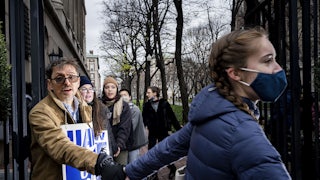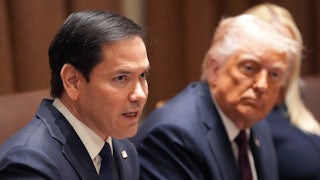Meow Wolf started as an art experiment on the industrial edge of Santa Fe, New Mexico, in an old bowling alley transformed into a place called the House of Eternal Return. Ordinary household fixtures—a refrigerator, a washing machine, a fireplace—became portals to a vast wonderland of colorful art and thousands of interactive objects. The trippy installation opened to the public in the spring of 2016 and was a near-overnight sensation: 500,000 people visited in 2019. Last year, Meow Wolf opened two new exhibits in Denver and Las Vegas. What was once a ragtag collective has become a multimillion-dollar company sitting squarely at the intersection of art and capitalism—and the competing pressures are obvious.
To exit the House of Eternal Return, a visitor walks through a neon coral forest in a person-sized aquarium. Push through the double doors at the end, and the real world rushes back: a hallway, signs to the restrooms, vending machines. The Learning Center—a space for community meetings and free programming, like story time—once immediately to the left, was shuttered indefinitely during the early days of the pandemic. In its place the gift shop expanded, sprawling across the lobby.
Partially in response to Meow Wolf’s stratospheric growth, its employees organized, and in October 2020, the company voted to recognize the Meow Wolf Workers Collective, an affiliate of the Communications Workers of America. With an upcoming ratification vote hoped for in March, the Meow Wolf union joins a wave of worker organizing at cultural institutions around the country, including the Museum of Contemporary Art in Los Angeles, the Guggenheim, and the Brooklyn Academy of Music (whose organizers offered advice to the fledgling union at Meow Wolf). Still, Meow Wolf is unique among these contemporaries—it’s a much younger company that grew very quickly, and it isn’t a nonprofit. It has managed to keep its reputation as a progressive leader in arts and entertainment, even as its former CEO moved into real estate development and despite a high-profile intellectual property dispute with one artist the company worked with. A new CEO from ViacomCBS was announced in January, joining a former Disney executive and a Utah-based Goldman Sachs alum in the company’s top three positions.
The union is asking that Meow Wolf underpin its innovative, bohemian aura with strong protections and higher wages for its employees. Like many people in creative fields, they were once encouraged to see themselves as iconoclast outsiders, laboring for free or close to nothing out of love for their art, but a dose of start-up culture and a major infusion of cash changed everything. Now they want to be seen as workers; for their value to be recognized the same way their company’s is.
Most of the reporting around Meow Wolf follows “this mythology of scrappy to successful: one and done,” said Emily Markwiese, a technical director at Meow Wolf who’s been involved with the group since she was a teenager and helped get the organizing process off the ground when it began in early 2020. The narrative that’s missing is one that’s told from the workforce’s perspective, she said, “what we’ve gone through over the past several years, adapting to a company that grew insanely fast; interacting with parts of the world that most of us never expected to.”
Meow Wolf originated as a collective around 2008, when a circle of twentysomething friends pooled their resources to rent warehouse space and make art on the industrial south end of Santa Fe—a major tourist destination and significant art market. Nobody in the original group got paid, and they were proudly anti-establishment. In the 2018 documentary Origin Story (commissioned by Meow Wolf), one founder describes an early iteration of the ensemble as “Santa Fe’s orphans of neglect,” while another calls the tony Canyon Road and downtown gallery scene, “a bunch of market-y bullshit.”
Despite taking pride in their outsider status, by 2015 the group had gotten a $60,000 grant from the City of Santa Fe, convinced Game of Thrones author and Santa Fe local George R.R. Martin to invest $2.7 million in the bowling alley conversion, and raised over $100,000 in a Kickstarter campaign. Their debut installation featured about 200 artists and was envisioned and constructed by Meow Wolf employees, contractors, and volunteers alike, all of whom worked countless hours to bring the exhibit to life.
“A lot of us that built the House ended up in visitor service positions after it opened,” Markwiese said. “I left for a year, and during that time, Meow Wolf became a company with a five-year plan, departments, a layer of management that had never been there before.” Markwiese noted an increase in out-of-state labor from the time the exhibit opened, which continues today.
Michael Wilson is a senior story editor at Meow Wolf and, like Markwiese, a member of the MWWC’s organizing committee. He was hired in 2018, but he’s known many Meow Wolf members for years. “It went from a group of people making literal trash art, like, dumpster diving, to when I was hired, we were negotiating with Amazon, Disney, the Jim Henson Company, and talking to people like Bjork,” Wilson said. The company offered good wages for Santa Fe—at $17 an hour, almost $5 higher than the city’s minimum wage—but, Wilson added, “we work with people all across the country, and our wages aren’t a great barometer anymore. Part of Meow Wolf’s mission is rattling the art market and making artists’ careers sustainable; to change people’s perceptions of what labor is worth. If we want to set an example, we should.”
In addition to better wages and job protections, the union wants a more equitable balance of power with management, which currently can change company policies at will. Tentative agreements on harassment and nondiscrimination policies are already in place, while agreements have yet to be reached on financials and a no strike, no walkout policy management wants to enforce and that the union opposes.
The company initially resisted the idea of a union at all, with CEOs saying in statements that “we feel the company works best without a union,” and refusing to let Denver and Las Vegas employees join the unit as a condition of recognition. Staff members told The New Republic that managers who expressed interest in the union or even talked about it faced repercussions. “There were a couple of managers who were providing contact information for another organizing member, who were put on probation and denied job opportunities,” said one former employee who asked to remain anonymous. (In response to questions, a spokesperson for the company said “Meow Wolf has been negotiating in good faith with the Union and we anticipate reaching a final contract soon.”)
There was also some resistance within the staff, which followed a familiar line of opposition to unions in creative fields and companies and nonprofits with a liberal sheen. Part of the problem, according to organizers, is the persistent cultural idea that artists are lucky to make money from their work at all. Before the 2020 vote, a small group of employees created Reunion for Meow Wolf; on their website, they call for ways to address issues at the company that can be “more progressive, creative, and flexible, while also getting the job done, not costing us dues, and not dividing the company.” They also cite Meow Wolf’s B-Corp status (a designation for companies that meet certain social and economic justice and environmental impact requirements) as a reason a union isn’t needed. (Meow Wolf’s B-Corp score is 80.2; the minimum score to qualify is 80.)
“People were sold an idea that unions were just for certain groups of people, that workers like artists and tech workers didn’t need a union,” Milagro Padilla, a staffer with CWA who worked on the Meow Wolf campaign, wrote in an email. “That couldn’t be further from the truth. Work is work, if you’re running fiber optic cables or designing worlds like the folks at Meow Wolf. Unions are far from perfect, but they are one of the best tools the working class has.”
For some people, the issue was not rocking the boat. “It’s not like I think Meow Wolf is an evil place or they’re going to lash out, but I have a mortgage, I’m worried about inflation and job security like everybody else, and I was scared,” said a second Meow Wolf employee, who spoke to The New Republic on condition of anonymity. They initially voted no for the union before signing their card last year. “I took a second look at the issues because I was inspired by the passion of my co-workers and by the risks they took.”
Meow Wolf does not disclose revenue but earned at least $38 million in ticket sales last year, according to a rough estimate by The Santa Fe New Mexican. In 2019, the company raised $158 million from 87 investors, in part to build its Denver and Las Vegas exhibits. Nonetheless, the pandemic hit it hard; there was a big round of layoffs and furloughs affecting over 250 people in April 2020, despite the company receiving $6.6 million in Paycheck Protection Program funds from the federal government.
Now, recovering from the upheaval of Covid-19, the MWWC sees the union as the best mechanism to keep the talented workers of Meow Wolf in New Mexico, a state that loses a lot of its homegrown young professionals.
“Unionizing is vital to the longevity of the company, and I fully believe it’s what’s saving it right now,” a third employee who spoke on condition of anonymity wrote in an email. “This job is a rarity: a salary, health care, even dental.… But we continue to live in society that doesn’t value art or the folks making it.… Even [at] MW, which was built from the ground up by artists, that sentiment is just inherent in the corporate structures. Artists are often seen as expendable, especially when your artwork becomes their artwork once it rolls out. Artists’ roles have the worst pay rate throughout the creative department. And why not, when there’s a line of unemployed artists outside at any given time? The irony is, most artists I know have the skills to be marketers, contract negotiators, budgeters, and leaders—they do it all the time in their private work. Corporations like [Meow Wolf] are the ones who need artists the most.”






